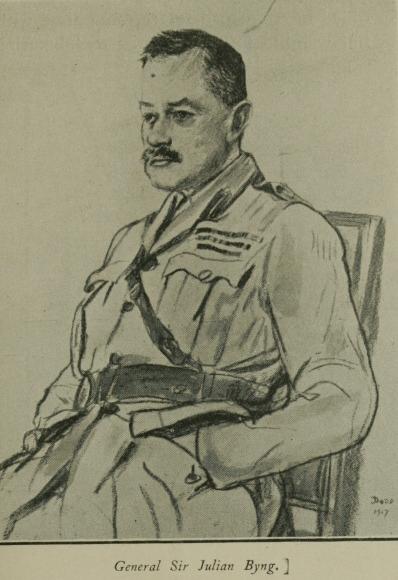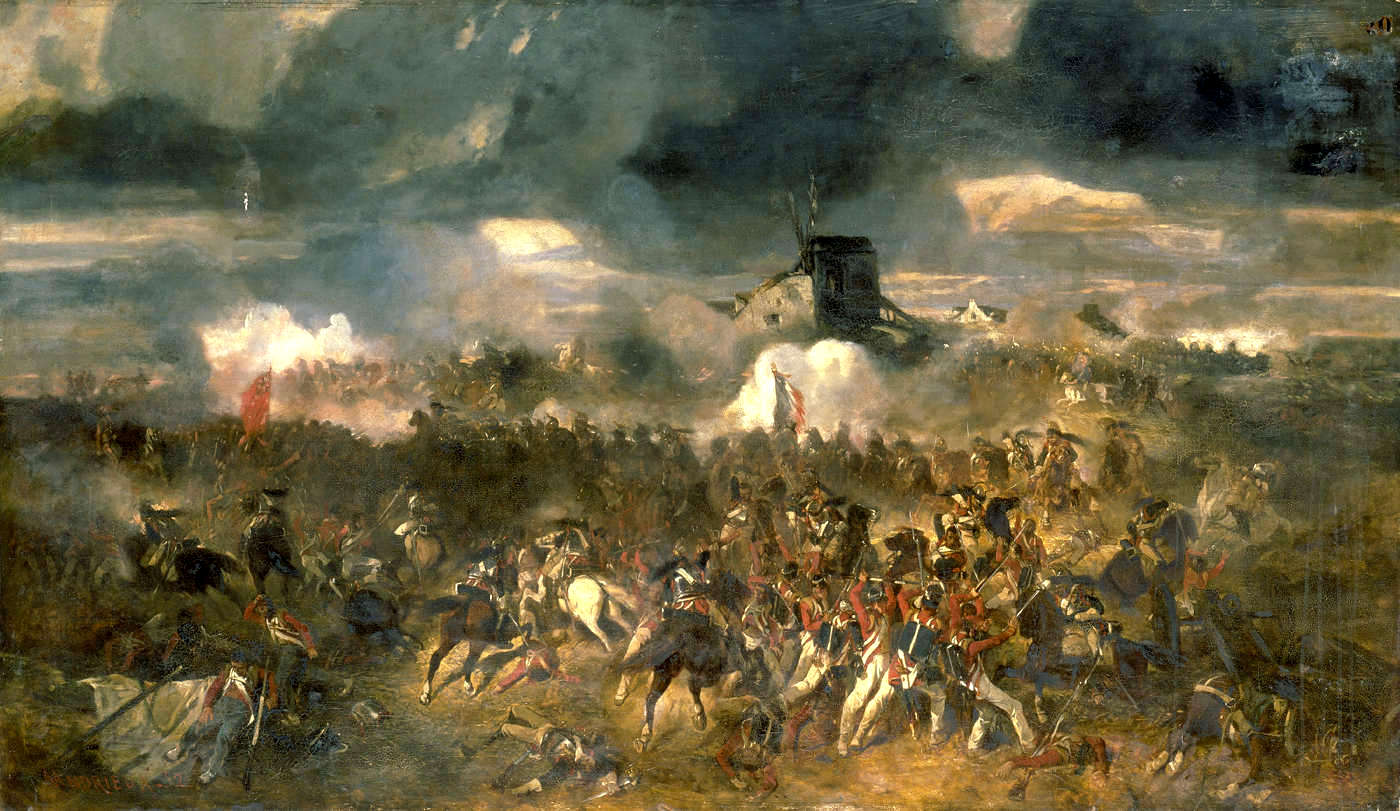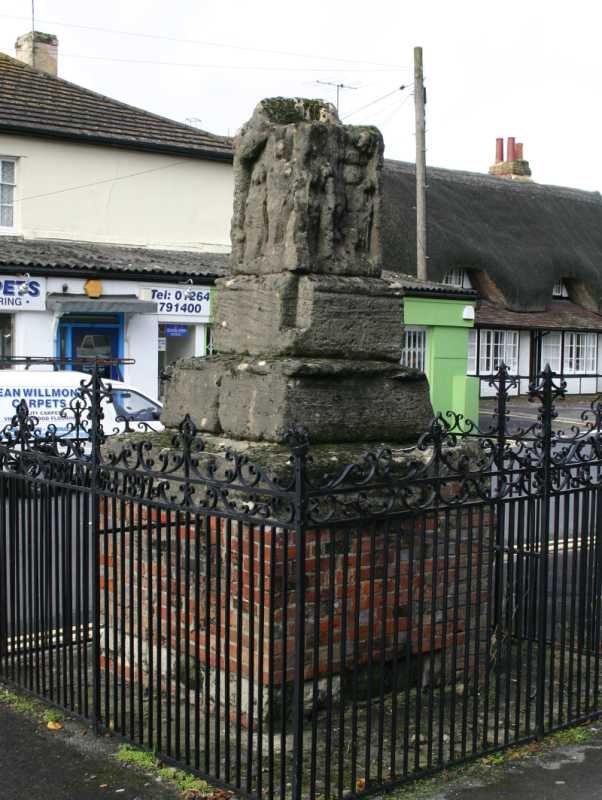|
3rd Cavalry Division (United Kingdom)
The 3rd Cavalry Division was a division of the British Army in the First World War. It was formed at Ludgershall, Wiltshire England in September 1914 under the command of Major-General the Hon. Julian Byng. The division moved to Belgium in the first week of October 1914, landing at Ostend, although its third Brigade was only formed there once. During the war the division took part in most of the major actions where cavalry were used as a mounted mobile force, and also many where the troops were dismounted and effectively served as infantry. On 11 November 1918, units of the division had reached the River Dender at Leuze and Lessines in Belgium, when orders were received that they would cover the advance of the British Second Army into Germany. They started the advance on 17 November, divisional headquarters being established at Waterloo on 21 November. The following year they wintered in Belgium, and the division was officially demobilised by 31 March 1919. History Formation ... [...More Info...] [...Related Items...] OR: [Wikipedia] [Google] [Baidu] |
Cavalry
Historically, cavalry (from the French word ''cavalerie'', itself derived from "cheval" meaning "horse") are soldiers or warriors who fight mounted on horseback. Cavalry were the most mobile of the combat arms, operating as light cavalry in the roles of reconnaissance, screening, and skirmishing in many armies, or as heavy cavalry for decisive shock attacks in other armies. An individual soldier in the cavalry is known by a number of designations depending on era and tactics, such as cavalryman, horseman, trooper, cataphract, knight, hussar, uhlan, mamluk, cuirassier, lancer, dragoon, or horse archer. The designation of ''cavalry'' was not usually given to any military forces that used other animals for mounts, such as camels or elephants. Infantry who moved on horseback, but dismounted to fight on foot, were known in the early 17th to the early 18th century as '' dragoons'', a class of mounted infantry which in most armies later evolved into standard cavalry while ... [...More Info...] [...Related Items...] OR: [Wikipedia] [Google] [Baidu] |
Julian Byng, 1st Viscount Byng Of Vimy
Field Marshal Julian Hedworth George Byng, 1st Viscount Byng of Vimy, (11 September 1862 – 6 June 1935) was a British Army officer who served as Governor General of Canada, the 12th since the Canadian Confederation. Known to friends as "Bungo", Byng was born to a noble family at Wrotham Park in Hertfordshire, England and educated at Eton College, along with his brothers. Upon graduation, he received a commission as a militia officer and saw service in Egypt and Sudan before enrolling in the Staff College at Camberley. There, he befriended individuals who would be his contemporaries when he attained senior rank in France. Following distinguished service during the First World War—specifically, with the British Expeditionary Force in France, in the Battle of Gallipoli, as commander of the Canadian Corps at Vimy Ridge, and as commander of the British Third Army—Byng was elevated to the peerage in 1919. In 1921, King George V, on the recommendation of Prime Minister David ... [...More Info...] [...Related Items...] OR: [Wikipedia] [Google] [Baidu] |
10th Hussars
The 10th Royal Hussars (Prince of Wales's Own) was a cavalry regiment of the British Army raised in 1715. It saw service for three centuries including the First World War and Second World War but then amalgamated with the 11th Hussars (Prince Albert's Own) to form the Royal Hussars (Prince of Wales's Own) in October 1969. History Early history The regiment was formed at Hertford in 1715 as Gore's Regiment of Dragoons, one of 16 raised in response to the 1715 Jacobite rising. The Rising ended before the unit was ready for action; while most of these temporary formations were disbanded in 1718, Gore's remained in being and spent the next 25 years on garrison duty, primarily in the West Country. It first saw active service during the 1745 rising, at the Battle of Falkirk Muir in January 1746 and the Battle of Culloden in April. As part of the reforms enacted by the Duke of Cumberland, it was retitled the 10th Regiment of Dragoons in 1751. During the 1756 to 1763 Seven Years' ... [...More Info...] [...Related Items...] OR: [Wikipedia] [Google] [Baidu] |
1st Dragoons
The Royal Dragoons (1st Dragoons) was a heavy cavalry regiment of the British Army. The regiment was formed in 1661 as the Tangier Horse. It served for three centuries and was in action during the First and the Second World Wars. It was amalgamated with the Royal Horse Guards to form The Blues and Royals in 1969. History Formation The regiment was first raised as a single troop of veterans of the Parliamentary Army in 1661, shortly thereafter expanded to four troops as the Tangier Horse, taking the name from their service in the Garrison of Tangier. For the next few years, the regiment defended Tangier, which had been acquired by the English Crown through the marriage of King Charles II to Catherine of Braganza in April 1662, from Moorish cavalry. The regiment consisted of four troops, three of which were originally troops in the ''English Regiment of Light Horse in France'' attached to the French army of Louis XIV and under the command of Sir Henry Jones. They were co ... [...More Info...] [...Related Items...] OR: [Wikipedia] [Google] [Baidu] |
6th Cavalry Brigade (United Kingdom)
The 6th Cavalry Brigade was a cavalry brigade of the British Army. It served in the Napoleonic Wars (notably at the Battle of Waterloo), in the First World War on the Western Front where it was assigned to the 3rd Cavalry Division, and with the 1st Cavalry Division during the Second World War. History Napoleonic Wars From June 1809, Wellington organized his cavalry into one, later two, cavalry divisions ( 1st and 2nd) for the Peninsular War. These performed a purely administrative, rather than tactical, role; the normal tactical headquarters were provided by brigades commanding two, later usually three, regiments. The cavalry brigades were named for the commanding officer, rather than numbered. For the Hundred Days Campaign, he numbered his British cavalry brigades in a single sequence, 1st to 7th. The 6th Cavalry Brigade consisted of: * 10th (Prince of Wales's Own) Regiment of (Light) Dragoons (Hussars) * 18th (King's Irish) Regiment of (Light) Dragoons (Hussars) * 1st ... [...More Info...] [...Related Items...] OR: [Wikipedia] [Google] [Baidu] |
Waterloo, Belgium
Waterloo (, ; wa, Waterlô) is a Municipalities of Belgium, municipality in Wallonia, located in the province of Walloon Brabant, Belgium, which in 2011 had a population of 29,706 and an area of . Waterloo lies a short distance south of Brussels, and immediately north-east of the larger town of Braine-l'Alleud. It is the site of the Battle of Waterloo, where the resurgent Napoleon was defeated for the final time in 1815. Waterloo lies immediately south of the official language border between Flanders and Wallonia. Etymology From Middle Dutch, composed of water (water, watery) + loo (forest, clearing in a forest, marsh, bog). History The name of Waterloo was mentioned for the first time in 1102 designating a small hamlet at the limit of what is today known as the Sonian Forest, along a major road linking Brussels, Genappe and a coal mine to the south. Waterloo was located at the intersection of the main road and a path leading to a small farming settlement in what is now Cense ... [...More Info...] [...Related Items...] OR: [Wikipedia] [Google] [Baidu] |
British Second Army
The British Second Army was a field army active during the First and Second World Wars. During the First World War the army was active on the Western Front throughout most of the war and later active in Italy. During the Second World War the army was the main British contribution to the Normandy landings on 6 June 1944 and advance across Europe. First World War The Second Army was part of the British Army formed on 26 December 1914, when the British Expeditionary Force was split in two due to becoming too big to control its subordinate formations. The army controlled both III Corps and IV Corps. Second Army spent most of the war positioned around the Ypres salient, but was redeployed to Italy as part of the Italian Expeditionary Force between November 1917 and March 1918. In 1919 it was reconstituted as the British Army of the Rhine.Edmonds (1987) Commanders * 1914–1915 General Sir Horace Smith-Dorrien * 1915–1917 General Sir Herbert Plumer * 1917–1918 General Sir Hen ... [...More Info...] [...Related Items...] OR: [Wikipedia] [Google] [Baidu] |
Lessines
Lessines (; nl, Lessen, ; pcd, Lissene, wa, Lissene) is a city and municipality of Wallonia located in the province of Hainaut, Belgium. As of the 2014 census, The municipality's total population was 18,637. The total area is 72.29 km² (27.91 square miles) which gives a population density of 247 inhabitants per km². The municipality consists of the following districts: Bois-de-Lessines, Deux-Acren, Ghoy, Lessines, Ogy, Ollignies, Papignies, and Wannebecq. Lessines is a municipality of Picardy Wallonia. It is primarily known as the birthplace of the Surrealist painter René Magritte (1898 – 1967). History Postal history The Lessines post office opened before 1830. It used postal code 71 with bars (before 1864), and 214 with points before 1874. Deux-Acren post office opened on 15 May 1866. It used postal code 104 with points before 1874. The Papignies post office opened on 18 February 1880, Ghoy and Ollignies on 25 May 1905, and Ogy on 5 November 1907. Po ... [...More Info...] [...Related Items...] OR: [Wikipedia] [Google] [Baidu] |
Leuze-en-Hainaut
Leuze-en-Hainaut (; pcd, Leuze-in-Hénau; wa, Leuze-e-Hinnot) is a city and municipality of Wallonia located in the province of Hainaut, Belgium. On 1 January 2018, it had a population of 13,886. The municipality consists of the following districts: Blicquy, Chapelle-à-Oie, Chapelle-à-Wattines, Gallaix, Grandmetz, Leuze-en-Hainaut, Pipaix, Thieulain, Tourpes, and Willaupuis. Famous landmarks * The Collegiate Church of Saint Peter was erected in 1745 on the site of a former Gothic church, destroyed by fire. The building's sumptuous interior features intricate woodwork, including the carved Louis XVth style panels of the confessionals, decorated with a variety of motifs, a sculpted representation of Saint Peter in chains, below the pulpit, and the organ casing. Twin towns * - Loudun (France) (1961) * - Ouagadougou Burkina Faso (1968) * - Carencro, Louisiana (United States The United States of America (U.S.A. or USA), commonly known as the United States (U. ... [...More Info...] [...Related Items...] OR: [Wikipedia] [Google] [Baidu] |
Ostend
Ostend ( nl, Oostende, ; french: link=no, Ostende ; german: link=no, Ostende ; vls, Ostende) is a coastal city and municipality, located in the province of West Flanders in the Flemish Region of Belgium. It comprises the boroughs of Mariakerke, Raversijde, Stene and Zandvoorde, and the city of Ostend proper – the largest on the Belgian coast. History Origin to Middle Ages In the Early Middle Ages, Ostend was a small village built on the east-end () of an island (originally called Testerep) between the North Sea and a beach lake. Although small, the village rose to the status of "town" around 1265, when the inhabitants were allowed to hold a market and to build a market hall. The major source of income for the inhabitants was fishing. The North Sea coastline has always been rather unstable due to the power of the water. In 1395 the inhabitants decided to build a new Ostend behind large dikes and further away from the always-threatening sea. 15th to 18th century The s ... [...More Info...] [...Related Items...] OR: [Wikipedia] [Google] [Baidu] |
Belgium
Belgium, ; french: Belgique ; german: Belgien officially the Kingdom of Belgium, is a country in Northwestern Europe. The country is bordered by the Netherlands to the north, Germany to the east, Luxembourg to the southeast, France to the southwest, and the North Sea to the northwest. It covers an area of and has a population of more than 11.5 million, making it the 22nd most densely populated country in the world and the 6th most densely populated country in Europe, with a density of . Belgium is part of an area known as the Low Countries, historically a somewhat larger region than the Benelux group of states, as it also included parts of northern France. The capital and largest city is Brussels; other major cities are Antwerp, Ghent, Charleroi, Liège, Bruges, Namur, and Leuven. Belgium is a sovereign state and a federal constitutional monarchy with a parliamentary system. Its institutional organization is complex and is structured on both regional ... [...More Info...] [...Related Items...] OR: [Wikipedia] [Google] [Baidu] |
Ludgershall, Wiltshire
Ludgershall ( , with a hard g) is a town and civil parish north east of Salisbury, Wiltshire, England. It is on the A342 road between Devizes and Andover. The parish includes Faberstown which is contiguous with Ludgershall, and the hamlet of Biddesden which is to the east on the border with Hampshire. History There is evidence of settlement in the late Bronze Age or early Iron Age at Windmill Down on the western edge of the parish. The ''Domesday Book'' of 1086 recorded small settlements at Ludgershall and Biddesden. The entry for ''Litlegarsele'' reads: " Edward of Salisbury holds Ludgershall. Alfward held it before 1066; it paid tax for one hide (about 24 acres). Land for 3 ploughs. In Lordship 2 ploughs, 3 slaves; 8 Cottagers with 1 plough. Pasture 3 furlongs long and 1 furlong wide; woodland ½ league long and 2 furlongs wide." The value was 100 shillings. The name "Litlegarsele" may come from "lytel", small and "garsheath", a grassy place, thus a "small grazing area" or ... [...More Info...] [...Related Items...] OR: [Wikipedia] [Google] [Baidu] |




.jpg)


